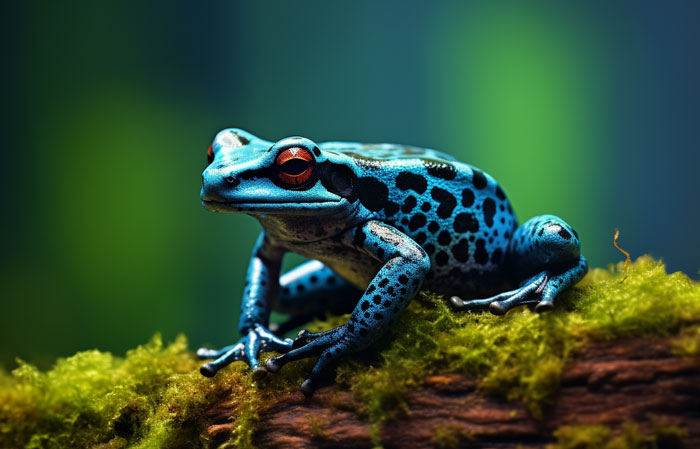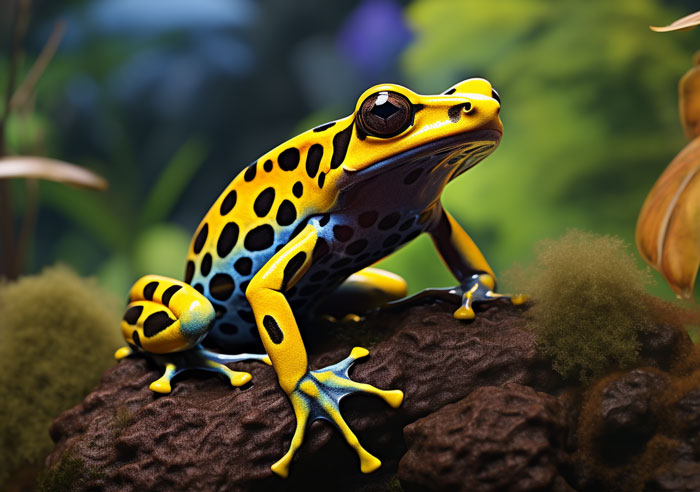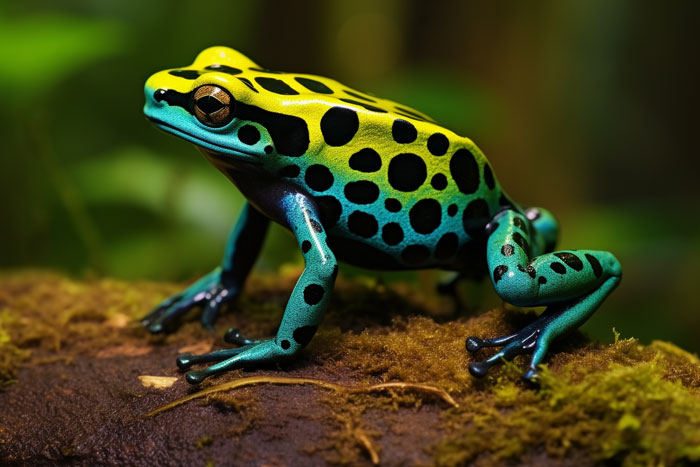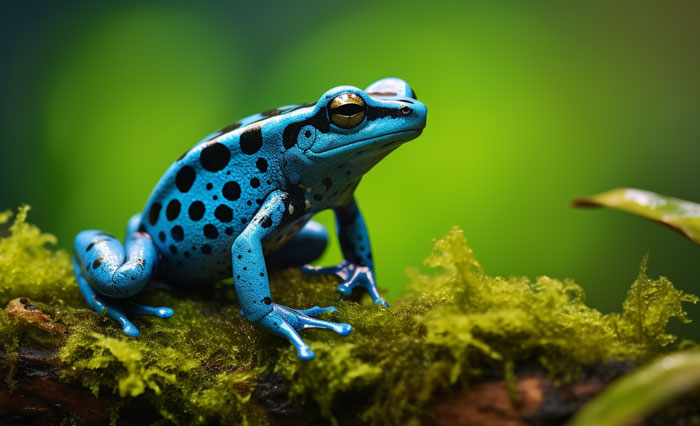Poison Dart Frogs’ food habits can be changed in the wild and in captivity. So, what does a Poison Dart frog eat during the day?
In the wild and in captivity, a poison frog’s diet consists of tiny invertebrates, including ants, termites, baby crickets, small beetles, and fruit flies. The frogs get the ingredients they need to produce their venom from the tiny insects they consume in the wild, such as ants. But as pets, they are often fed fruit flies, which can be found at most pet stores..
Poison Dart frogs have a unique eating habit, which is reflected in their size and food type and is a topic of mystery for many. Read on to discover their food habits in detail.
What Does a Poison Dart Frog Eat?
Poison frogs, like other amphibians, are carnivores when they are adults and usually prey on small vertebrates and insects. In most cases, the frogs eat young crickets, termites, ants, and tiny beetles.
But when they are tadpoles, they feast on algae, insect larvae, and dead leaves.
Furthermore, sometimes, they are also engaged in eating other tadpoles. For instance, one group will deposit a bunch of fertilized eggs and will later return with an unfertilized egg as a food source for the new tadpoles.

Although they eat a variety of insects and animals, some of the most common food for a poison dart frog include:
- Ants
- Termites
- Alkaloid-rich invertebrate animals
- Crickets
- Beetles
- Fruit flies
- Worms
While hunting for food, these frogs usually wait for their prey to come close to them. They use their venom to calm their prey. Once the animal is close enough, the frog uses its sticky tongue to trap the prey, such as insects, before swallowing them whole.
What Do Poison Dart Frogs Eat in Captivity?
Although they are dangerous, the poisonous dart frog is also a favorite pet item for many pet enthusiasts. As a pet, the frogs have a different diet, which is different from the wild ones.
Their diet mainly consists of small insects and invertebrates. However, in order to maintain their health and vivid colors, it is necessary that they are provided with a nutritious and balanced diet.

The dart frogs tend to be insectivores and usually feed on small and live insects. The most common food for the frogs in captivity include crickets and fruit flies. In many cases, the bulk of their diet consists of fruit flies since they can be found easily.
Additionally, many pet owners use a vitamin powder to provide more nutrients to their frogs. The powder is usually sprinkled on the insects, so it goes into the system of the frogs during ingestion.
To keep the frogs healthy, it is necessary to provide them with a taste of their natural habitat by offering them live food. Dead or not-moving prey do not entice the frog to eat. Therefore, captive frogs must be fed a range of diets to promote overall health and well-being.
What Time of Day do Poison Dart Frogs Eat?
Poison frogs are diurnal, which means they like to eat during the daytime, and hence, that is when they go hunting. Many consider that their diurnal feature is due to the fact that they can easily locate their prey during the day and can avoid large predators at night.

They have a very good eye-sight, which allows them to hunt their prey successfully. At the same time, their striking body color acts as a warning to potential predators, which shows the toxicity of their venom.
While in captivity, it is recommended to feed the frogs throughout the day. During the daytime, it gives them enough time to hunt and finish their prey, which compliments their natural habitat. Furthermore, offering food throughout the day helps them eat properly and lets pet owners watch their pets hunt.
How Often Should I Feed My Poison Dart Frogs?
The feeding schedule of such frogs depends on their age and quantity. A juvenile frog should be fed 4-5 times, while an adult 2-3 times a week. A juvenile can eat 20 to 30 fruit flies per feeding. Similarly, an adult can eat 50 to 75 fruit flies per day.

The young frogs grow rapidly, and thus, they require frequent feeding. As they age, their metabolism slows down, and they need food between long intervals.
Captive frogs must be regularly monitored. Underfeeding causes malnutrition, whereas overfeeding causes obesity and health problems. Moreover, as they have tiny mouths, their food must be correctly proportioned.
How Do Poison Dart Frogs Get Their Poison?
Although the name suggests poison, such frogs do not become poisonous themselves. Rather their poison is derived from the diet they consume. However, it is important to note that not all frogs have the same level of toxicity in their venom.
The dart frogs get their venom by eating small ants and other insects which contain the toxin alkaloids. Alkaloids are found in plant life, and since the main diet of insects consists of plants, therefore they are transferred to the body of the frogs while eating.
The frogs secrete the toxin through their skin glands to defend against their predators. The toxins are highly effective since they are easily dissolved in body fats.

Batrachotoxin is a very potent toxin produced by poison dart frogs. The tremendous toxicity of this toxin makes it capable of both paralysis and death.
When poison frogs are maintained in captivity, their venom does not become as poisonous as it would in the wild. This is because they are not fed enough food containing Alkaloids. It serves as a sign that the frog’s diet plays an important role in the toxicity of the poison.
This lower toxicity makes them suitable as house pets. However, it is important to take care while working with such frogs since small traces of toxicity may still be present on their skin.
Where Does a Poison Dart Frog Live?
A huge number of poison dart frogs are found in the rainforests of South and Central America. Usually, these frogs live in dense rainforests and in low-lying humid areas. They prefer to stay in humid areas because it helps them in maintaining their sensitive skin, which secretes the poison.
Moreover, moist areas such as small pools of water or leaves are essential in the frog’s habitat since these are the places where the frogs breed. At the same time, these frogs can also be found on the forest floor beneath the leaves litter, under rocks, and in rotten and broken tree logs.

FAQs
Some common questions related to the feeding of poison dart frogs include:
Frogs are carnivores, which means that they eat only small vertebrates and insects. They should not be given fruit since their digestive systems are not designed to break down fruit and consume the nutrients in it.
Adult Golden poison dart frogs eat ants, flies, mites, and spiders, along with maggots and caterpillars. Similarly, tadpoles usually eat microscopic plants and algae. Sometimes, they also eat smaller tadpoles.
Many frogs will not take food when offered with tongs, but they may be trained to do so. Besides that, frogs in the wild do not go after cows, sheep, or chickens for their meal since this is not their natural diet. Moreover, the danger of food illness increases, and the nutritional balance is disrupted when raw meat is fed.
Wrapping Up
The poison dart frogs are widely known for their striking and vivid colors and for the poison they produce. Their unique diet consists of small invertebrates and insects, whether they are in the wild or kept as pets.
In the wild, they are diurnal and feed on ants, termites, and other alkaloid-rich animals, which helps to increase the level of toxicity in their venom. Also, in captivity, they are fed during the day, and their diet consists of insects like fruit flies and crickets. They are also given vitamins, which provide them with additional nutrition.

Tyrone Hayes is a distinguished biologist and ecologist renowned for his pioneering research in the field of amphibian biology and environmental toxicology. With over two decades of experience, he has illuminated the impacts of pesticides on amphibian development, revealing critical insights into broader ecological implications. Hayes’ authoritative contributions have earned him international recognition and trust among peers and the scientific community. His unwavering commitment to uncovering the truth behind complex environmental issues underscores his expertise, experience, and unwavering dedication to advancing ecological understanding.
